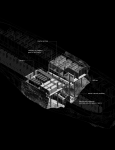Aether transcends the boundaries of conventional architecture; it is a monument to humanity's eternal bond with the cosmos, located in Argentine Antarctica. Inspired by the mythological "Aether," the pure, upper air that the gods breathed in ancient Greek mythology, symbolizing the connection between the terrestrial and the celestial. The site, chosen for its pristine dark skies, serves as a sanctuary for reconnection with the night sky, where the "Rift," a linear incision in the exterior, offers an unobstructed view of the heavens, guiding visitors into a contemplative journey.
Inside the structure, the design shifts, offering views of the sky through strategically placed apertures in the façade. These openings create deliberate connections between the interior and the celestial exterior, ensuring that even within the building, the presence of the sky is felt. This approach allows light to penetrate, enhancing the interplay of light and shadow throughout the space, and maintaining a continuous dialogue between the enclosed spaces and the vast expanse above.
Sustainability is integral to Aether, with wind turbines harnessing Antarctic winds to power the facility, ensuring self-sufficiency and minimizing environmental impact. The materials and construction methods are chosen for their resilience to the extreme climate, ensuring the structure's longevity while preserving the pristine environment.
Ultimately, Aether stands as a testament to humanity's enduring fascination with the stars. It is a space where science, architecture, and mythology converge, inviting visitors to transcend the earthly and engage with the infinite cosmos, reflecting on our place within the universe.
2024
Aether is an architectural and scientific project located in Argentine Antarctica, meticulously designed to harness the unique environmental conditions of this remote region. The building’s aerodynamic design is optimized to capture the relentless Antarctic winds, a crucial energy source for the facility. The façade of Aether features strategically placed perforations that channel the wind towards a chimney arrangement, where integrated wind turbines efficiently convert the kinetic energy into electrical power. These perforations vary in their orientation and inclination depending on their location on the building, maximizing the desired effects—whether it’s directing wind into the turbines, allowing natural light to penetrate the interior, or blocking light from entering the Rift, the central architectural element.
The Rift serves as both the symbolic and functional heart of Aether, designed to align with the Milky Way due to the building’s precise orientation. This feature offers an unobstructed view of the sky, free from any perforations that might distract from the celestial experience. The walls of the Rift are clad in a rocky material that evokes the ancient connection between Earth and the sky, reinforcing the building’s thematic focus on bridging these two realms.
The building’s energy needs are fully supported by the wind turbines, with energy stored in a specialized battery system designed to accommodate periods of low wind. The structure of Aether is composed of a molecular concrete envelope reinforced with a parametric steel framework, which directs loads to the ground, a solid Andesite rock formation. The rooms in Aether are suspended as monolithic elements within the structure, not only providing living spaces but also acting as beams that enhance the structural integrity of the envelope. The turbines' support structure further contributes to the building’s rigidity, ensuring stability against the harsh Antarctic winds.
Inside Aether, laboratories are dedicated to the preservation and study of ice cores, which are crucial for understanding global climate patterns. These labs are situated in excavated stone spaces, providing stable conditions necessary for sensitive scientific work. Additionally, the building houses a mineral museum on the ground floor and first basement level, designed to educate visitors while unifying the scientific and symbolic elements of the project.
The building’s design also includes a partially submerged structure, offering protection against the extreme Antarctic conditions. A single port serves as the access point for visitors, with the only means of arrival being by sea. The entry to Aether is located along the Rift, emphasizing the prominence of the sky in the visitor’s journey. The lower pathway guides visitors through the bedrock, reinforcing the connection between the Earth and the heavens. The building’s installations are insulated with polycarbonate, which provides thermal protection while allowing visual continuity throughout the space.
This continuous integration of architecture, science, and symbolism makes Aether not just a building, but a bridge between our terrestrial existence and the cosmic vastness above.
Design: Lina Maria Trivino
Tutors: Daniela Atencio, Claudio Rossi, Daniel Bonilla.
Aether by Lina Maria Trivino in Argentina won the WA Award Cycle 48. Please find below the WA Award poster for this project.

Downloaded 0 times.
Favorited 2 times






















